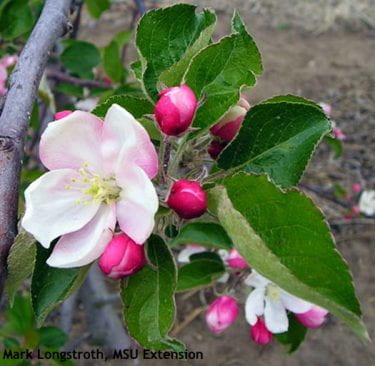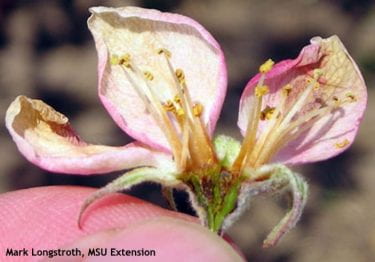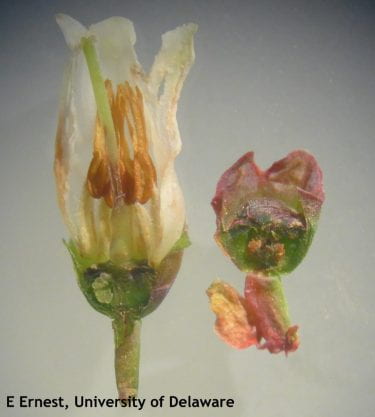Gordon Johnson, Extension Vegetable & Fruit Specialist; gcjohn@udel.edu
Apples were in various stages of bloom during the recent frost events on April 29 and 30 when temperatures dropped to the mid-20s in some locations and there have been reports of injury, especially in frost pockets. The following information on apple freeze injury is from Michigan State University:
In apples, the fruit buds are really small shoots with both flowers and leaves. An apple flower cluster is shown in the photo below. In apples, the flower in the center of the flower cluster is the oldest and most developed and will be the first flower to bloom. This central flower is called the king bloom and is the most desirable of the flowers in the cluster. The king bloom has the potential to be the largest fruit.

The king bloom of the apple flower cluster has opened, but the side blooms are still closed.
The king bloom of the apple flower cluster has opened, but the side blooms are still closed. The king bloom is more susceptible to freeze injury at all stages of the apple bud development in the spring and is often the first flower killed in the cluster.
Since the king bloom is also the most advanced flower in the cluster, it is most likely to be killed in a frost. Another difference between apples and stone fruit is that the pistil is buried inside the base of the flower and not exposed above it as in stone fruit. This means that it is often necessary to tear the flower apart to see if the center of the flower is brown or black. The flower in the photo below is a king bloom killed by frost.

The dark brown center of this apple flower indicates it was killed by a freeze.
When checking apples from frost damage, check the king and side blooms separately. Many times the king blooms are killed and many of the side bloom are undamaged.

The king bloom in the center of the cluster has lost its petals.
The dark brown centers and signed appearance of the petals indicate that both kind and side blooms were killed in a freeze the morning this picture was taken. The king bloom in the center of the cluster has lost its petals.
See this site for a full list of critical temperatures in tree fruit: https://www.canr.msu.edu/uploads/files/TreeFruitCriticalTemperatures.pdf
Blueberries
Blueberries were also blooming or in early fruit formation during this period. According to North Carolina State University: “For highbush blueberries, when the blossoms are open, a temperature of 27°F for more than a few minutes causes damage. Immediately after corolla drop and before the berry begins to swell is the most sensitive stage. A few minutes below 28°F will result in damage. As the berry begins to enlarge, susceptibility is similar to the critical temperature of 28°F for open blossoms.”

The blueberry fruit on the right was damaged by freezing temperatures and will not mature. Seeds inside the ovary have turned brown. The flower on the left was not frozen, seeds remain plump and green.
